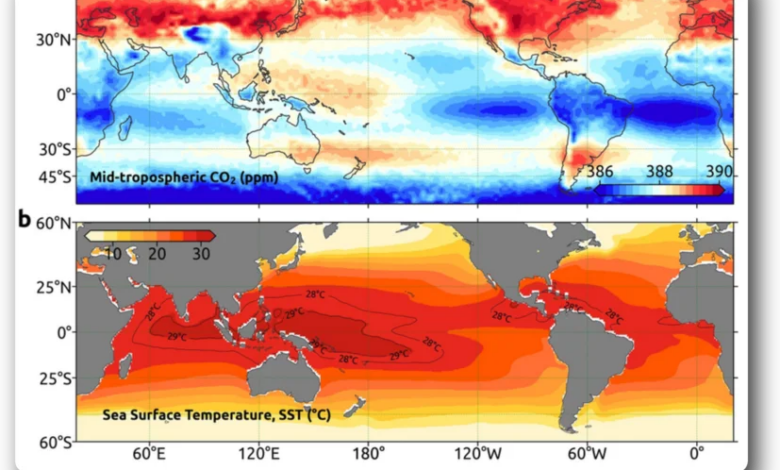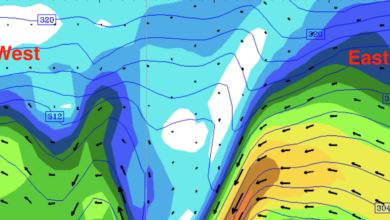Another episode of Augean Stables – Watts Up With That?

Guest Post by Willis Eschenbach (@weschenbach on eX-Twitter)
Our esteemed moderator, Charles, who receives my eternal thanks for maintaining the hits here on WUWT, asked me to look at a new article yclept Multivariate analysis refutes the theory of human-caused atmospheric carbon dioxide increase: The sea surface temperature rule by Dai Ato, an independent researcher in Japan. It seems to have been used. I will call this paper Ato2024.
I hadn’t gone far when the alarm bells rang. The study conducted a multivariate analysis using publicly available data to examine the impact of sea surface temperature (SST) and human emissions on atmospheric CO₂ levels.
It is concluded that SST is an independent determinant of the annual increase in atmospheric CO₂ concentrations. Human emissions are found to be irrelevant in the regression models.
And most notably it says:
Furthermore, predicted atmospheric CO₂ concentrations, using regression equations obtained for SSTs derived from the UK-HADLEY centre after 1960, show extremely high correlations with actual CO₂ concentrations (Pearson correlation coefficient r = 0.9995, P < 3e-92).
BZZZZT!! Whenever I get such a high r value, I know for sure that I am doing something very wrong… I will come back to that.
First, let me start with one of the three variables in their analysis, which is SST, CO2, and emissions. Here are three reconstructions of SST since 1854 from three different groups.

Figure 1. Global monthly mean sea surface temperature (SST). The yellow area on the right is the part of the record analyzed by Ato.
Although there are some differences, the overall pattern is clear. There is a warming of the SST from about 1850 to about 1870, a cooling until about 1910, a warming until about 1940, a cooling until about 1965, and a warming since then.
Looking at that, I can see why Ato didn’t want to use the full record—it doesn’t support his claim that SST is an independent determinant of atmospheric CO2 levels. The CO2 data (Figures 2 and 3 below) don’t look like that.
So how does he justify the cut? Well, Mauna Loa’s CO2 data starts around 1960. But it can be extended back further using ice core CO2 records. Here’s what that looks like.

Figure 2. Background atmospheric CO2 concentrations measurements at Mauna Loa and ice cores, AD 1000–2010. Data: Ice core Mauna Loa
Ato2024 suggests that the ice core records are inaccurate. However, this is negated by the close agreement between the ice core records with each other and with the Mauna Loa measurements as shown above.
Here is a closer look at the most recent data since 1850, corresponding to the time frame of sea surface temperature (SST) in Figure 1.

Figure 3. As in Figure 2, but only data after 1850
Since the ice cores match and match the Mauna Loa data I have no problem considering it a good reconstruction of CO2 levels after 1850.
The problem, of course, is that pre-1960 ocean temperatures are nothing like pre-1960 CO2 levels… and this discrepancy completely skews Ato2024. So he has to ignore it.
Next, how did he get such a large correlation, 0.9995, between SST and CO2 in the post-1960 data? Part of the answer lies in what he looked at. Here is the post-1960 CO2 record from Mauna Loa that he used. Note that he didn’t use monthly data, just annual data. This makes it easier to get a Pearson correlation coefficient higher than “r”.

Figure 4. CO2 observations at Mauna Loa Observatory, along with linear trend lines.
The recent increase in CO2 has been a very slow accelerating curve, almost a straight line. This leads to many false correlations because such curves are easy to replicate. as we will see below. This is a common problem in climate science.
But that’s just the first problem. The main problem is the process he used. Here’s the description from the article.

Note that the delta symbol (∆) in the equations means “change in”. So, ∆CO2 is the change in CO2 from year to year.
Translated means:
- Calculates a best-fit linear estimate for annual changes in CO2 (∆CO2), based on Hadley HadSST sea surface temperatures.
- The predicted atmospheric CO2 concentration would then be equal to the initial atmospheric CO2 concentration plus the cumulative sum of the estimated annual changes in CO2.
Here’s a graph of the first part of that calculation, matching SST to the annual change in CO2.

Figure 5. Annual change in atmospheric CO2 after 1960 (∆CO2), along with the linear trend line of ∆CO2 and the best estimate of ∆CO2 based on Hadley HadSST4.0.1.
Now, there is something strange about graphing delta CO2, or ∆ anything. It involves a few strange changes. I will use the ∆CO2 graph in Figure 5 as an example.
First, any overall linear trend in the CO2 data is converted to an overall deviation from zero (non-zero mean) in the ∆CO2 plot.
Second, any overall acceleration in the CO2 data is converted into an overall linear trend in the ∆CO2 plot.
So looking at Figure 5 we can see that the ∆CO2 data has both a positive and accelerating trend. We can see both of those trends in Figure 3 above.
And now that we have adjusted the SST to the ∆CO2 data so that we can estimate ∆CO2, we just need to add those changes together to estimate the baseline CO2 data. Here is the result.

Figure 6. Mauna Loa CO2 data and Ato2024 estimates of Mauna Loa CO2 data
By this point, I had replicated his results.
Now, remember I said that a correlation coefficient of 0.999+ means there is some serious error in the logic. So… what’s not to like?
In his note asking me to review this paper, Charles The Moderator included an interesting AI analysis of the paper, specifically (emphasis mine):
Based on my analysis of the article, the main problem of circular reasoning appears to lie in the method used to predict atmospheric CO2 concentrations from sea surface temperature (SST) data. Specifically:
• The author uses multiple linear regression to derive an equation relating the annual CO2 increase to SST over the period 1960-2022.
• This equation was then used to “predict” CO2 concentrations over the same time period 1960-2022.
Predicted and measured CO2 concentrations were extremely highly correlated (r = 0.9995).
Circular reasoning occurs because the same data is used to derive the equation and to test its predictive power. The main equations involved are:
Regression equation (from Step 7 in the paper):
Annual CO2 increase = 2.006 × HAD-SST + 1.143 (after 1959)
Prediction equation:
[CO2]n = Σ[ΔCO2]I + Cst
Where [CO2]n is the predicted CO2 concentration, [ΔCO2]i is the annual increase calculated from the regression equation and Cst is the actual CO2 concentration in the first year.
By using this method, the author is essentially fitting the equation to the data and then using that same adjusted equation to “predict” the data it was derived from. This ensures an extremely high correlation that does not actually demonstrate any predictive power or causality.
A proper analysis would use separate training and testing datasets or use techniques like cross-validation to avoid this circularity.
The extremely high correlation reported is almost certainly a product of this flawed methodology rather than evidence of a true relationship between SST and atmospheric CO2 levels.
And AI was right. Well, partly right. They were right that the problem wasn’t that Ato2024 fitted SST to CO2. The problem was that Ato2024 didn’t keep half the data to verify the results. It’s easy to predict something when you already know the results…
However, and this is a big problem… while that alone is enough to completely rule out the conclusions, there is another really big problem. To illustrate this, I used the Ato2024 method. But instead of using sea surface temperature as an input to fit the ∆CO2 data like Ato2024 did, I fit a straight line to the ∆CO2 data. That’s the blue line in Figure 3 above.
And using the Ato2024 method, I converted that line to the equivalent CO2 data shown in red in Figure 7 below.

Figure 7. As in Figure 6, plus a red line showing the result of using a simple straight line instead of the sea surface temperature (SST) used Ato2024.
Interesting. Using the Ato2024 method to adjust the variable to ∆CO2, A straight line as input has the same effect as using SST as input.
But that doesn’t really show the full extent of the problem. To do that, I first split the SST, line, and ∆CO2 data in half. I use the first half to fit the SST or line to ∆CO2. Then I use those results to estimate the change in CO2. Figure 8 shows that result.

Figure 8. Same as Figure 7, but using only the first half of the data to fit the model, then using the entire data to see how well the model performs.
This graph shows two distinct problems. First, although the fit is significantly worse than in Figure 6, the Pearson correlation coefficient “r” remains essentially unchanged… meaning it is not an appropriate measure for this particular problem.
Next, the line continues to work just as well when using SST as the independent variable… not good. This points to a deep problem with the basic Ato method.
To illustrate the problem, I will present Figure 5 above again.

In summary, any overall linear trend in the CO2 data is first converted to an overall deviation from zero (non-zero mean) in the ∆CO2 plot.
Second, any overall acceleration in the CO2 data is converted into an overall linear trend in the ∆CO2 plot.
And here’s the key. When you fit SST data (or more importantly, any data) for ∆CO2 data, you will get a fitted signal with the same non-zero mean and the same trend as the ∆CO2 data.
Not only that, the fit will be balanced, with the amount above and the amount below the trend line being equal.
And all of that ensures that if you start trying to predict a smooth curve, when you reconstruct the signal using the Ato2024 method, you will get an answer VERY close to the smooth curve no matter what variable you use to reconstruct the signal.
And that is why using a straight line is just as effective as using SST or any other variable as a basis for estimating CO2.
I weep for the death of honest peer review…
Best wishes to everyone,
because
Yes, you’ve heard this before: When you comment, please quote the exact words you are discussing. This avoids unnecessary misunderstandings.
Related



